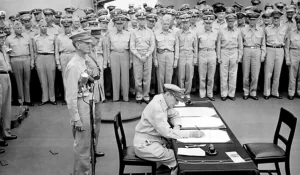World War II (WWII) was a global conflict from 1939 to 1945 involving major world powers divided into two main alliances: the Allies (led by the United States, the Soviet Union, the United Kingdom, and others) and the Axis (headed by Nazi Germany, Italy, and Japan). The war began with Germany’s invasion of Poland in 1939 and quickly spread, leading to extensive battles in Europe, Asia, and the Pacific. The war saw widespread devastation, technological advancements, and the Holocaust, in which millions were systematically murdered. The war ended in 1945 with the unconditional surrender of Germany and Japan, reshaping the world order, giving rise to the Cold War, and leaving a lasting impact on global politics and society.
What were the turning points of World War II?
World War II had several critical turning points that significantly impacted the course and outcome of the conflict. These moments marked shifts in momentum and strategy for both the Allies and the Axis powers. Here are some of the most significant turning points of World War II:
- Battle of Stalingrad (1942-1943): The Battle of Stalingrad was a major turning point on the Eastern Front. The Soviet Union successfully defended the city against the German forces, marking the first major defeat for Nazi Germany and leading to their retreat from the Soviet Union. The battle showcased the resilience of Soviet troops and marked a shift in momentum in favor of the Allies in Eastern Europe.
- Battle of Midway (1942): In the Pacific Theater, the Battle of Midway was a decisive naval battle between the United States and Japan. The U.S. Navy’s victory halted Japan’s advance in the Pacific and weakened its naval power. The battle also marked the first significant defeat of Japanese naval forces and marked a turning point in the Pacific War.
- North African Campaign (1942-1943): The Allied victory in the North African Campaign, particularly the Battle of El Alamein, pushed Axis forces out of North Africa and weakened their presence in the Mediterranean. This victory secured crucial supply lines and positioned the Allies for future operations in Europe.
- D-Day and Normandy Landings (1944): The Allied invasion of Normandy, also known as D-Day, marked the beginning of the liberation of Western Europe from Nazi occupation. The successful landings on June 6, 1944, established a foothold on the continent and paved the way for the eventual defeat of Germany.
- Battle of Kursk (1943): This was a significant battle on the Eastern Front, where the Soviet Union successfully repelled a massive German offensive. The battle marked the last major German offensive on the Eastern Front and further weakened their military capabilities.
- Italian Campaign (1943-1945): The Allied invasion of Italy led to the fall of Mussolini’s fascist regime and the eventual surrender of Italy. While the campaign was marked by slow progress and difficult terrain, it diverted German forces from other fronts and contributed to their overall weakening.
- Fall of Berlin (1945): The capture of Berlin by Soviet forces in April 1945 marked the final phase of the war in Europe. Adolf Hitler’s suicide and the German surrender shortly afterward effectively ended Nazi Germany’s control.
- Atomic Bombings of Hiroshima and Nagasaki (1945): The use of atomic bombs by the United States on the Japanese cities of Hiroshima and Nagasaki led to Japan’s surrender and the end of World War II in the Pacific.
These turning points collectively contributed to the eventual victory of the Allies and the defeat of the Axis powers in World War II. They shaped the post-war world order and had lasting effects on global politics and diplomacy.
ROLE OF INDIA IN WORLD WAR II –
India played a significant role in World War II, both in terms of its contribution to the Allied war effort and its impact on its own struggle for independence from British colonial rule. Here are the key aspects of India’s role during the war:
- Military Contribution: India provided a substantial number of soldiers to the British Indian Army, which fought in various theaters of the war. Indian soldiers fought in North Africa, the Middle East, Southeast Asia, and Europe. The Indian Army’s contributions were crucial to many key battles and campaigns.
- Burma Campaign: Indian troops played a pivotal role in the Burma Campaign against the Japanese forces. This campaign was important for preventing Japanese expansion in Southeast Asia and protecting British interests in the region.
- Air and Naval Support: The Indian Air Force and the Indian Navy also provided support to the Allied forces. Indian pilots participated in the Burma Campaign and in defending India against Japanese air attacks. The Indian Navy aided in escorting convoys and patrolling the Indian Ocean.
- Financial and Material Support: India provided significant financial resources to support the British war effort. The colonial government imposed war taxes and collected funds to aid the Allies. Additionally, India contributed raw materials, including food, oil, and minerals, which were essential for the war industries.
- Impact on Independence Movement: The war had a profound impact on India’s struggle for independence. The British Indian Congress Party, led by figures like Mahatma Gandhi and Jawaharlal Nehru, demanded a significant role in governance and administration in exchange for supporting the war effort. However, when the British failed to meet these demands, the Quit India Movement was launched in 1942, advocating for an end to British rule. The movement faced repression, and many leaders were arrested.
- INA and Subhas Chandra Bose: Subhas Chandra Bose, a prominent nationalist leader, formed the Indian National Army (INA) in collaboration with the Japanese. The INA aimed to liberate India from British rule with Japanese assistance. Though the INA’s military impact was limited, its existence and Bose’s efforts stirred nationalistic fervor.
- Cripps Mission and Post-War Changes: The Cripps Mission in 1942 promised India greater self-governance after the war, but it was rejected by Indian leaders as inadequate. The experience of the war and the sacrifices made by Indians led to increased demands for independence, eventually culminating in India’s independence in 1947.
India’s role in World War II highlighted its capacity for sacrifice and its aspirations for self-governance. The war experience accelerated the momentum for independence, and by the time the war ended, India’s political landscape had changed significantly, leading to its eventual liberation from British colonial rule.
HOW WOULD WORLD WAR II END ?
World War II ended with the unconditional surrender of Nazi Germany in May 1945. This surrender was prompted by the advance of Allied forces from the West and the Soviet Union from the East, culminating in the fall of Berlin. Adolf Hitler’s suicide and the capture of key German cities signaled the collapse of Nazi Germany’s control.
In the Pacific, World War II ended after the United States dropped atomic bombs on the Japanese cities of Hiroshima and Nagasaki in August 1945. The devastating impact of these bombings, coupled with the Soviet Union’s declaration of war on Japan, led to Japan’s unconditional surrender in September 1945.
These events marked the conclusion of World War II , bringing an end to the global conflict and reshaping the post-war world order.
The war in the west, September 1939–June 1940 (World War II)
The war in the west from September 1939 to June 1940 refers to the early stages of World War II, particularly the conflict between the Allied Powers (primarily France and the United Kingdom) and the Axis Powers (primarily Nazi Germany) in Western Europe during that period. This phase of the war is often referred to as the “Phoney War” or the “Drôle de guerre” (strange war) because it was characterized by a lack of major military operations on the Western Front despite the outbreak of war.
Here are some key events and developments during this period:
- Outbreak of World War II: World War II officially began on September 1, 1939, when Nazi Germany, under the leadership of Adolf Hitler, invaded Poland. In response, the United Kingdom and France declared war on Germany on September 3, 1939, honoring their commitments to defend Poland.
- The Phoney War: Following the declarations of World War II, there was a relatively calm period on the Western Front. There were no large-scale military offensives or major battles during this time, leading to a sense of inaction and a false sense of security for the Allies.
- Maginot Line: France had constructed the heavily fortified Maginot Line along its border with Germany to defend against any potential invasion. However, the Germans bypassed this line by invading through Belgium and the Netherlands, catching the Allies off guard.
- Blitzkrieg in the West: On May 10, 1940, Germany launched a lightning-fast military offensive known as the “Blitzkrieg” (lightning war) against Western Europe. German forces swiftly overran Belgium, the Netherlands, and Luxembourg, and then pushed into France.
- Dunkirk Evacuation: As the German forces closed in on the British Expeditionary Force and other Allied troops in northern France, a massive evacuation operation known as the Dunkirk evacuation (Operation Dynamo) took place between May 26 and June 4, 1940. Around 330,000 British and French soldiers were evacuated from the beaches of Dunkirk and brought back to Britain.
- Fall of France: Despite some resistance, the German advance proved overwhelming, and Paris fell to the Germans on June 14, 1940. France signed an armistice with Germany on June 22, 1940, effectively ending the major phase of fighting in Western Europe. The northern part of France was occupied by German forces, while the southern part, known as Vichy France, became a puppet state collaborating with the Germans.
The period from September 1939 to June 1940 marked a significant turning point in World War II, with the rapid collapse of France and the evacuation of British and Allied forces from Dunkirk. It set the stage for the subsequent Battle of Britain and the continued conflict in Western Europe, which would last until the eventual liberation of France in 1944.
The invasion of Norway (World War II)
The invasion of Norway, also known as Operation Weserübung, was a military campaign launched by Nazi Germany during World War II in April 1940. The invasion aimed to secure Norway and parts of Denmark as strategic assets and sources of critical resources, particularly iron ore from Sweden, which was being transported through Norwegian ports. The invasion of Norway had several key objectives:
- Strategic Importance: Norway’s geographic location made it strategically valuable. Control of Norway’s coastline, ports, and airfields could enable the Germans to disrupt Allied shipping in the North Atlantic and protect their own maritime interests.
- Iron Ore Supplies: Northern Sweden was a significant producer of iron ore, a vital resource for Nazi Germany’s war machine. The iron ore was transported by rail to Norwegian ports, where it was loaded onto ships bound for Germany. Securing this supply line was a primary objective.
- Naval and Air Bases: Norway’s fjords provided natural shelter for naval vessels and submarine bases, and its airfields could be used for launching air operations against Britain and the North Sea.

The invasion unfolded as follows:
- Denmark: On the morning of April 9, 1940, German forces invaded Denmark with relative ease. The Danish government surrendered later that day.
- Norway: Simultaneously, German forces launched a full-scale invasion of Norway. They captured several key Norwegian ports and cities, including Oslo, Bergen, Trondheim, and Narvik, in rapid succession. The Norwegian military offered determined resistance, but they were ultimately outmatched by the German invaders.
- British and Allied Response: The British and French responded to the German invasion by sending expeditionary forces to Norway to support the Norwegians and attempt to regain control of key ports. However, they faced logistical and operational challenges, and the campaign was hampered by a lack of coordination and effective leadership.
- Evacuation: As the situation deteriorated, the British and French forces conducted a series of evacuations from Norwegian ports, similar to the earlier Dunkirk evacuation in France. The evacuation of troops from Narvik was one of the most significant and successful operations.
- Occupation: By early June 1940, German forces had occupied most of Norway, establishing a puppet government and a military presence throughout the country. The Norwegian king and government, along with many military personnel, escaped to exile in London, where they continued to support the Allied war effort.
The invasion of Norway had far-reaching consequences for the course of World War II. It extended the conflict into Scandinavia and contributed to the eventual German defeat in the Battle of the Atlantic, as the Allies sought to disrupt German control of Norwegian ports. The occupation of Norway also had significant political, economic, and strategic implications throughout the war.
The invasion of the Low Countries and France (World War II)
The invasion of the Low Countries and France, often referred to as the Battle of France, was a pivotal military campaign during World War II that took place in the spring of 1940. This campaign marked the rapid conquest of Belgium, the Netherlands, Luxembourg, and ultimately France by Nazi Germany. Here’s an overview of the invasion:
1. Timeline of the Invasion:
- May 10, 1940: German forces launched their offensive, bypassing the heavily fortified Maginot Line by invading Belgium, the Netherlands, and Luxembourg. This move caught the Allies off guard.
- May 13, 1940: German forces broke through the Ardennes Forest, a region believed to be impassable for large armies, and began a rapid advance towards the English Channel.
- May 26 to June 4, 1940: The Dunkirk Evacuation (Operation Dynamo) took place, in which British and Allied forces were evacuated from the beaches of Dunkirk, France, to England. This operation saved a significant portion of the British Expeditionary Force.
- June 5 to June 6, 1940: German forces captured Paris, the capital of France.
- June 10, 1940: Italy declared war on France and the United Kingdom.
- June 14, 1940: German forces entered Paris, marking the fall of the French capital.
- June 22, 1940: France signed an armistice with Germany, leading to the occupation of northern France. The southern part of France became Vichy France, a puppet state collaborating with the Germans.
2. Blitzkrieg Tactics:
- The German invasion was characterized by the Blitzkrieg, or “lightning war,” tactics. These tactics involved the use of fast-moving mechanized units (panzer divisions), combined with air support and infantry, to rapidly encircle and overwhelm enemy forces.
- The Germans exploited weaknesses in the Allies’ command and communication systems, making use of radio and flexibility in their strategies.
3. Outcome:
- The swift German victory in the Battle of France shocked the world and demonstrated the effectiveness of Blitzkrieg tactics.
- With France’s surrender, the Germans gained control of northern France, while the southern part became the Vichy regime, which was nominally independent but heavily influenced by Germany.
- The Battle of France led to a period of relative stability in Western Europe, known as the “Phoney War” or “Drôle de guerre,” until the Germans turned their attention to Britain in the Battle of Britain.
4. Implications:
- The fall of France had profound implications for the course of World War II. It left Britain as the primary Allied power in Western Europe and set the stage for the Battle of Britain and the ongoing conflict in Europe.
- The French Resistance and exiled Free French forces, led by General Charles de Gaulle, continued to fight against the Axis Powers from abroad.
The invasion of the Low Countries and France was a critical moment in the early years of World War II, leading to a period of German dominance in Western Europe that would persist until the Normandy landings in 1944 and the liberation of France.
